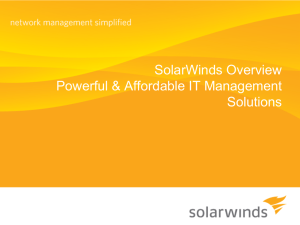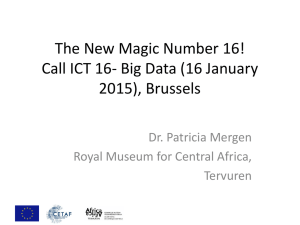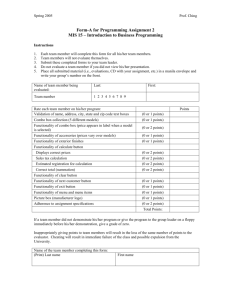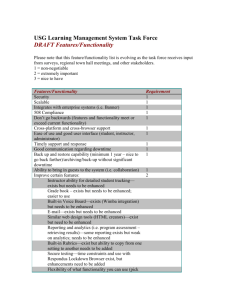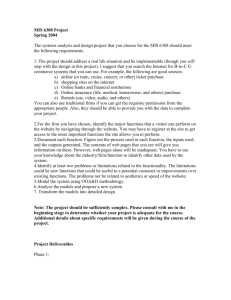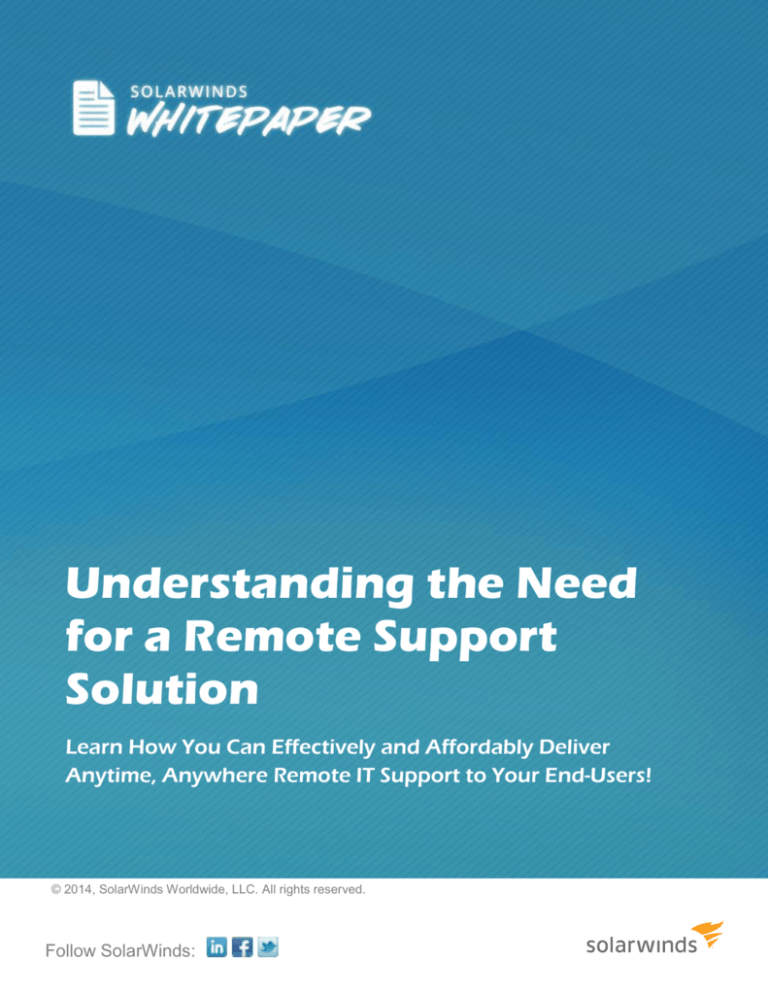
Understanding the Need
for a Remote Support
Solution
Learn How You Can Effectively and Affordably Deliver
Anytime, Anywhere Remote IT Support to Your End-Users!
© 2014, SolarWinds Worldwide, LLC. All rights reserved.
Follow SolarWinds:
Introduction
In today’s global workplace, it is not uncommon for an organization’s employees to be accessing IT resources around the
clock. This has led to an increased need for 24/7 IT support. Fast and efficient technical support processes are critical to
ensure that your day-to-day operations aren’t hindered by IT performance issues, regardless of time or location.
The concept of ‘anytime, anywhere IT support’ is here to stay because end-users require support, computers require
troubleshooting, and servers require updates and maintenance. Without a remote support solution, technicians need to be
physically present at an end-user’s computer to troubleshoot and resolve technical issues. This is not only time-consuming
and inefficient, it’s also costly and not scalable to the demands of most of organizations. Remote support software enables
IT pros to overcome time and location constraints and access critical network resources to provide technical support to endusers, anytime, anywhere.
Remote support tools typically include remote control software that allows technicians to take control of an end-user’s
computer as if they were physically sitting at the keyboard. Some remote support tools also let system administrators
perform remote administration tasks, such as restarting services, managing Active Directory® (AD) objects, or viewing and
clearing event logs without needing to initiate remote sessions, making remote troubleshooting almost transparent to endusers. Many of these tools also offer in-session chat capabilities enabling help desk and desktop support pros to
communicate directly with an end-user while troubleshooting.
Top Reasons IT Teams Use Remote Support Tools
The consumerization of IT and global business operations commonly require technical support 24/7.
The 3rd-party remote support tools can be used to manage large networks efficiently from one location at a minimal cost
as technicians need not be physically present at each site.
The operating system’s remote administration functions have limited functionality.
Remote support tools offer extensive support to nearly all IT infrastructure components, such as Active Directory, virtual
machines (VMs), and different operating systems including Mac OS X®, Windows®, and Linux®, etc.
Remote support solutions offer additional functionality to provide a better remote-session experience and more control
to the IT admin during the session.
You can improve IT administration operational efficiency and realize time and cost savings.
There’s a multitude of remote support tools on the market. How do you identify the right remote support tool for your IT
needs? Use the following factors as a guideline:
1. Company size. How many IT technicians will use the remote support tool?
2. Types of platforms/operating systems that need IT support.
3. Simplicity. How easy and intuitive is the tool to configure and use?
4. Scope of the remote tool’s administration functionality.
5. Return on investment (ROI). What are the long-term cost advantages of owning the remote support solution?
Follow SolarWinds:
2
Evaluating the Right Remote Support Solution for Your IT Needs
It is essential that you choose a solution that is affordable and provides robust and flexible functionality to support end-users
wherever they are located—inside or outside the firewall, with or without VPN connectivity. The following sections discuss
some factors to help you select the right remote support solution.
The Free vs. Paid Dilemma
Free Tools
Remote access functionality is included with most of the operating systems on the market. For example, Remote Desktop
Connection is included with Windows. It uses the Remote Desktop Protocol which enables technicians to access and
troubleshoot computers on a network.
Mac and Linux operating systems make use of Virtual Network Computing (VNC), a platform-independent remote access
technology based on remote frame buffer protocol. There are also open source tools and services available on the Internet
for remote access and remote control. Although these tools are free and available with some operating systems, there are
drawbacks to be aware of before you rely entirely on them for your remote support needs.
Limited functionality. Free tools usually offer only remote access functionality and don’t have the features included in more
comprehensive remote support solutions, such as:
Remotely troubleshoot Windows computers, perform administration tasks, and control desktops, laptops, and
servers.
Manage multiple Active Directory domains.
Support end-users from iOS® and Android™ devices.
No technical support or maintenance. Open source free tools do not offer support or maintenance. Therefore, they might
not be sustainable as a long-term option for your IT needs.
Paid Solutions
Many 3rd-party vendors offer remote support solutions that are designed to meet the needs of IT admins. These remote
support solutions typically include remote control functionality that allows an IT admin to take control of an end-user’s
computer and perform remote administration tasks from a simple-to-use console. Unlike the remote accessibility that’s preequipped with Windows, 3rd-party tools have extensive feature sets that allow an admin to manage the IT resources in
small organizations to large global networks with multiple branches. These solutions have an array of features that meet
the needs of IT admins from all kinds of network and systems environments and organization sizes.
Follow SolarWinds:
3
Using a 3rd-party tool also means that you are often entitled to technical support and all the product’s enhancements and
upgrades. With many 3rd-party vendors available on the market, a customer service and support option is an essential
prerequisite for choosing the right remote support tool.
Types of Offerings: Pro Cloud or No Cloud?
SaaS or Cloud-based
SaaS remote support solutions are based on a subscription model which allows users to have access from anywhere. This
gives IT admins the ability to remotely support end-users and also manage multiple systems in one action.
Security. While most cloud-based solutions offer the latest security measures, it is important to remember that data
exchanged during remote support sessions passes through a 3rd-party gateway or host server. This means that
security for these tools is essentially outsourced. This may create compliance issues for organizations with sensitive
security needs.
Infrastructure. SaaS and cloud-based remote support solutions require very little investment in infrastructure
because the solution provider hosts most of the needed hardware in their own environment.
Licensing. SaaS solutions are typically based on a subscription model which renews monthly or annually. For most
SaaS offerings, this means that the remote support software is rented rather than owned by the organization using
it. Even though cloud-based remote support services reduce the need for additional investment in infrastructure,
the total cost of ownership can be higher than on-premises solutions because of recurring license fees.
On-Premises (Self-hosted) Software
On-premises (or self-hosted) remote support solutions are installed within your IT infrastructure regardless of the location
of the systems being supported with it. They could be inside or outside the firewall (through an Internet proxy server) whether
they are connected through VPN or not. This helps avoid any security issues related to transmitting data through 3rd-party
servers and systems. Unlike most SaaS offerings, self-hosted solutions are not rented and data does not pass through 3rdparty hosts. You have complete control of your data and security.
On-premises solutions were the first breed of remote support solutions on the market. The underlying architecture of many
of them has evolved from a peer-to-peer to a more centralized structure with server components. Some of these solutions
have also matured to include a broader set of IT admin tools and functionalities in addition to remote connectivity and
control.
Beyond simple remote control, some on-premises solutions offer additional systems administration tools that IT pros need
for many of their daily tasks. For example, Active Directory management and remote Windows administration tools for
troubleshooting remotely without needing full remote control sessions. Logical groupings of these tools together with remote
control tools can save a lot of time for busy IT pros.
Follow SolarWinds:
4
Remote Support Options with On-Premises Software
Inside-the-firewall support: IT admins can use remote support software on their computers to connect to the client
computers within the corporate network.
Inside-and-outside-the-firewall support: In addition to offering support to end-users within the network (inside the
firewall), you can also establish secure remote connections to computers located outside the firewall via an Internet
proxy.
Licensing: Unlike the SaaS subscription model, on-premises solutions are usually sold via perpetual licensing. This
type of license gives users perpetual access to the software with modest annual maintenance costs that include
support and/or upgrades to newer versions as they are made available. This significantly reduces the total cost of
ownership over SaaS solutions.
What to Look for in an Effective Remote Support Solution
1. Ease of Use
Within a single, simple-to-use administrative console you should be able to
Establish remote sessions on multiple computers
Share files with remote users
Use built-in chat for easy communication
Take screenshots of the remote desktop during a remote session
Leverage the benefit of remote administration and remote control functionalities
2. Built-in Remote Control and Screen Sharing
The remote support functionality should allow IT admins to take control of end-users’ computers while maintaining the option
to let them view the troubleshooting session.
3. Remote Windows Administration & Troubleshooting
Remote administration refers to tasks that IT admins would normally have to do by taking control of a remote computer.
Look for a remote support solution that delivers the right tools and utilities to remotely perform Windows administration tasks
on end-users’ computers and also manage Active Directory objects—all from a single, intuitive management console.
4. On-the-Go Remote Access
IT support technicians often need to provide support even when they are out of the office or during an on-call rotation. Look
for a remote support solution that includes mobile remote desktop functionality for on-the-go IT support. Consider tools that
allow you to leverage mobile apps and establish remote sessions from your mobile and tablet interface.
Follow SolarWinds:
5
5. Security
Security is a core requirement of an effective remote support solution. A report published by the information security vendor,
Trustwave identified remote access as the most widely used method of infiltration to gain access to confidential corporate
data in 2012. Given its functionality, a remote support tool can offer easy access to your network if security is not a key
component of the solution in use. Give careful consideration to remote support solutions that offer security options such as
advanced remote access privilege management and smart card authentication, while using today’s top encryption
standards.
6. Centralized Management
With larger organizations, managing licenses and users is a complex exercise. A centralized architecture allows for easier
user, host list, and license management.
Simpler deployment and connectivity of remote support software
An Internet proxy component for secure, outside-the-firewall support
More efficient management of all users and permissions
Creation and sharing of a global host list for fast and efficient remote connections
Activation and control of licenses
7. Pricing and total cost of ownership
Evaluate solutions that are affordable, and at the same time, do not compromise on functionality or security. Compare costs
between different vendors’ licensing models making sure to compare the initial investment and year-over-year expenditures
that can increase with some SaaS offerings.
Follow SolarWinds:
6
How DameWare® Can Help
DameWare Remote Support (DRS) from SolarWinds® is an affordable and easy-to-use remote support solution that lets
you assist users, anytime, anywhere. No VPN required! DameWare Remote Support includes a host of features that
enable a technician to remotely connect to end-users’ computers and perform remote administration tasks from an
intuitive interface. DameWare offers a powerful collection of systems administration utilities from an easy-to-use interface.
Highlights of DameWare Remote Support
Provide secure support to end-users located inside and outside the firewall
Remotely control desktops, laptops, and servers
Manage multiple Active Directory domains
Perform Windows administration tasks remotely without having to initiate a full remote control session
Support end-users from your iOS® or Android® devices
Centrally manage users, licenses, and global host lists from an easy-to-use administration console.
Learn More About DameWare
1. Video:
DameWare Remote Support Product Overview
2. Datasheet:
DameWare Remote Support Datasheet
About SolarWinds
SolarWinds (NYSE: SWI) provides powerful and affordable IT management software to customers worldwide. Focused
exclusively on IT Pros, we strive to eliminate the complexity in IT management software that many have been forced to
accept from traditional enterprise software vendors. SolarWinds delivers on this commitment with unexpected simplicity
through products that are easy to find, buy, use, and maintain, while providing the power to address any IT management
problem on any scale. Our solutions are rooted in our deep connection to our user base, which interacts in our online
community, thwack®, to solve problems, share technology and best practices, and directly participate in our product
development process. Learn more at http://www.solarwinds.com.
Follow SolarWinds:
7



